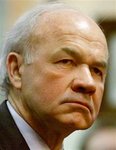Enron Corporation
Enron started humbly enough in 1985 from the merger of two natural gas pipeline companies. The rise of Enron over the next 15 years was meteoric. As a result of pipeline deregulation, Enron emerged as an energy trader – matching buyers and sellers while making huge profits as a broker. Enron also expanded into other business areas, including water, fiber optics, newsprint, and telecommunications. Annual revenues rose from about $9 billion in 1995 to over $100 billion in 2000. Enron was listed as the 6th largest company in the world, by revenues, in 2001. Enron was a major political contributor, with nearly $6 million in campaign contributions since 1990. President George W. Bush referred to Enron CEO Ken Lay as “Kenny Boy.” Enron frequently appeared on lists of the “best companies to work for” and “most innovative companies.”
The Enron bubble burst over a period of a few months in late 2001. Enron’s stock price had already been sliding for months, from $80 per share in February to around $30 in early October. Enron had been using its stock value as collateral to obtain loans from complicated “partnerships.” These partnerships allowed Enron, using questionable accounting techniques, to exclude this debt from its annual reports and thus inflate its apparent profits. On October 16, 2001, Enron third-quarter report indicated a $638 million loss along with an unexplained reduction in shareholder equity of $1.2 billion related to these partnerships.
 Kenneth Lay, Enron CEO
Kenneth Lay, Enron CEO After this announcement, things unraveled quickly. The Securities and Exchange Commission announced an investigation the next week. By early November, Enron’s stock price had fallen to less than $10 per share, forcing it to borrow billions of dollars in an attempt to save the company. Enron’s accounting firm, Arthur Anderson, was accused of shredding documents and complicity in the deception. Enron’s stock was downgraded to “junk” status and hit $0.70 per share on Nov. 28. On December 2, Enron filed for bankruptcy.
Investors lost about $60 billion in the Enron collapse. Among the hardest hit were Enron employees who had most of their 401(k) retirement value in Enron stock. Many of these employees saw their retirement savings completely depleted. By early 2004, 14 former Enron executives had been indicted under a federal investigation (seven had pleaded guilty).
On May 25, 2006, Jeffrey Skilling, former CEO of Enron Corporation, was convicted of 19 of 28 counts of securities and wire fraud and insider trading. He was sentenced to 24 years, 4 months in prison and was ordered to restore the ENRON pension fund with $26 million out-of-pocket. Ken Lay was convicted on all six counts of securities and wire fraud and faced a total sentence of up to 45 years in prison. He, however, died due to a heart attack while vacationing in Aspen, Colorado, before sentencing was scheduled.
Further Reading
